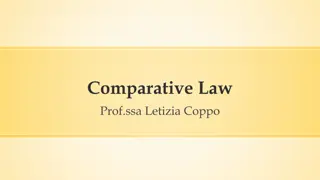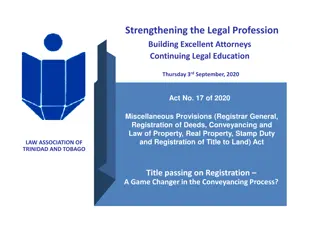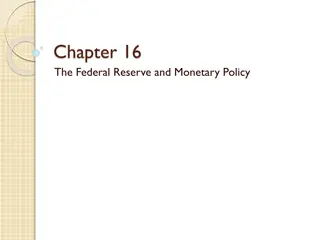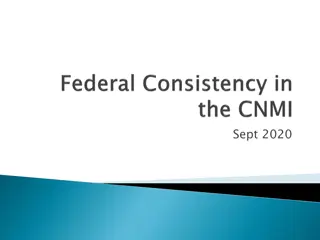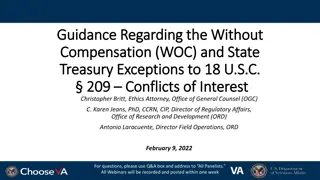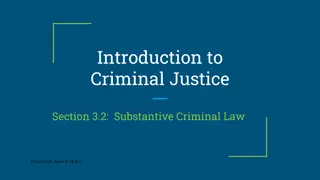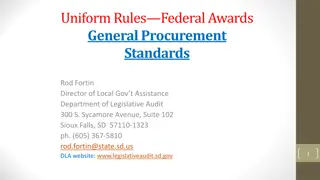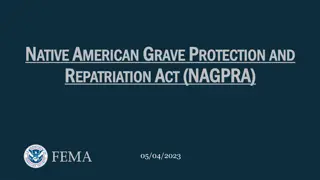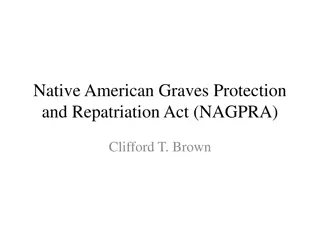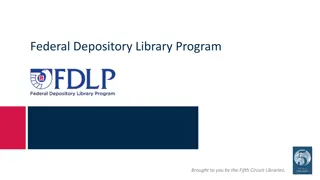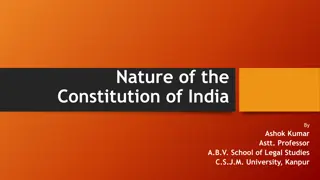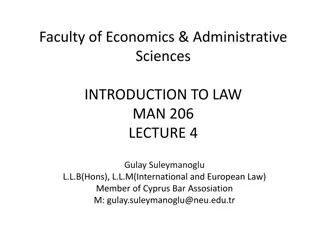Understanding the Federal System in American Law
The American legal system is rooted in a division of powers between the States and the Federal government. Federal law fills gaps and complements State laws, with Federal courts having jurisdiction over disputes involving different States or Federal issues. The Constitution and Bill of Rights protect citizens' rights at both State and Federal levels, enhancing the harmonious functioning of the legal framework.
Download Presentation

Please find below an Image/Link to download the presentation.
The content on the website is provided AS IS for your information and personal use only. It may not be sold, licensed, or shared on other websites without obtaining consent from the author. Download presentation by click this link. If you encounter any issues during the download, it is possible that the publisher has removed the file from their server.
E N D
Presentation Transcript
Comparative Law Prof.ssa Letizia Coppo
THE COMMON LAW TRADITION (NORTH) AMERICAN LAW
THE FEDERAL SYSTEM The system is based on a separation between the competence of the States and the competence of the Federation, the borders of which, though, are not always well defined. According to the X Amendment, the powers that are not expressly delegated to the Constitution (i.e. the Federation) and are not precluded to the States, are reserved to these latter or to the People.
THE FEDERAL SYSTEM Generally speaking, private law matters fall within the competence of States. Art III of the Constitution provides the diversity jurisdiction clause, according to which Federal Courts are competent to settle disputes between citizens from different States. On of the most thorny questions is what law should they apply in deciding such cases (see below).
THE FEDERAL SYSTEM According Amendment and the Bill of Rights, no State shall enact or apply any law as to deprive US citizens of the privileges and immunities provided at the Constitutional level. to the combination between the XIV Nowadays almost all the rights acknowledged by the Bill are protected against States at the Federal level.
THE FEDERAL SYSTEM Federal law, though, plays a gap-filling role: it is as if the Congress (i.e. the federal legislator) acts on the background of the corpus juris of the single States, like the legislator acts on that common law which applies unless derogated from by statutes. For instance, Federal courts can acknowledge a certain right and leave the remedy to the States or the opposite.
THE FEDERAL SYSTEM Competence of federal courts: in principle, the State and the federal level are parallel, i.e. whatever issue of state or federal law can be decided by state or federal courts. But federal courts can be addressed only in diversity of jurisdiction or for a federal question .
THE FEDERAL SYSTEM Diversity of jurisdiction: disputes between citizens from different States. Federal questions: disputes concerning also (but not only) matters that fall within the competence of the federal level. The problem is again which law should be applied.
THE FEDERAL SYSTEM Hierarchy: at the top of the pyramid stands the Federal Supreme Court, who is the last instance both for state level questions in diversity jurisdiction and for federal questions . Also state courts can address the Supreme Court, but only for the alleged violation of federal principles and rights, regardless if provided by the Constitution.
THE FEDERAL SYSTEM So the competence of the Federal Supreme Court on disputes decided by state courts is limited. For the disputes that do not involve the violation of federal rights and principles, state courts must resort to state supreme courts, which are the normal 3rdinstance courts. Thus, the creation of a single federal Supreme Court did not lead to the unification of law at a federal level.
THE COURT SYSTEM Full dualism between state and federal courts, as they are both present in almost all states and both have at least two instances: Trial courts or county courts (they decide both on facts and on the merits of the dispute) + specialised courts, municipal courts and justices of the peace Appellate courts or circuit courts (they decide only on the merits)
THE COURT SYSTEM At the top, in several states, there is a state supreme court, that serves as a third instance. The top of the federal level there is the Federal Supreme Court, which in some cases has original jurisdiction (conflicts among states), in some others, appellate jurisdiction (if appeals comes from States supreme courts, it can decide only on federal questions and then refer the judgment back on the merits).
THE SUPREME COURT Its role is compared to the one of English monarchy, but with far more power. Judges are appointed life-long by the US President upon proposal of the Senate. The Court is addressed through the writ of certiorari and has full discretion in deciding which cases to accept. Certiorari denied is significant for understanding politics see Brown v. Board of Education. the position towards court s
THE PROBLEM OF FEDERAL COMMON LAW It does not deal with the allocation of jurisdiction between the state and the federal level, but with the law applicable. Obviously the supremacy clause compels state courts to apply federal law and precedents whenever the case at stake involves issues falling within the federal competence. More controversial is which law should federal courts apply when deciding a case involving state law in diversity jurisdiction
THE PROBLEM OF FEDERAL COMMON LAW It is equally obvious that federal courts must apply the laws of the different states. But the problem is: when they are addressed in diversity do they have to apply the law of the State in which they are seated or are they entitled to create autonomous common law rules, especially for filling the gaps left by local statutes?
THE PROBLEM OF FEDERAL COMMON LAW Key-point: interpretation of section 34 of 1789 JudiciaryAct. The laws of the several states [...] shall be regarded as rules of decision in trials at common law in the Courts of the United States in cases where they apply Does the laws of the several states refer to statutory law only or also to common law ?
THE PROBLEM OF FEDERAL COMMON LAW Leading cases - Brown and Yellow Taxicab (dissenting opinions by Holmes, Stone and Brandeis, but decision was that federal courts are not bound by state precedents, but only by statutory law) - Swift v. Tyson (Justice Story decided that in matters of general commercial law federal courts are not bound by the sitting state precedents). - Erie R.R. v. Tompkins (Brandeis; overruling; still in force)
THE PROBLEM OF FEDERAL COMMON LAW Brown and Yellow Taxicab v. Black and White Taxicab holding In suit in federal court to restrain interference with railroad's contract granting exclusive privileges to plaintiff taxicab company in soliciting patronage at depot, federal courts are not bound by Kentucky decisions that such contracts are invalid, since, in determining questions of general law, federal courts are free to exercise their own independent judgment. Sixth Circuit Court of Appeals affirmed.
THE PROBLEM OF FEDERAL COMMON LAW Swift v. Tyson holding Federal courts were to apply state statutory law, but not common law, to state cases.
THE PROBLEM OF FEDERAL COMMON LAW Erie R.R. v. Tomkins summary The decision in Erie involved a railroad accident. The plaintiff, Tompkins, was walking alongside Erie's railroad tracks in Pennsylvania when a train passed. An open door struck him and knocked him under the train, severing his arm. In most states, Tompkins could sue for negligence of the railroad and recover monetary damages for his loss. In Pennsylvania, however, Tompkins would have been considered a trespasser. He was not to recover for an ordinary negligence claim in the state court of Pennsylvania, because under the law of that state, a claimant had to show "wanton" negligence on part of the Defendant to recover. Thus, Tompkins brought his case in federal court to avoid the unfavorable state law. He subsequently won. However, on appeal the Supreme Court held, in an opinion drafted by Justice Brandeis, that such decisions and inconsistent rulings based on a general federal common law were unconstitutional, and that decisions by a state supreme court were "laws" that federal courts were bound to follow under the Rule of Decision Act. Brandeis noted that the Court felt that Swift allowed federal courts to make unconstitutional modifications of the substantive law of a state. He noted that it violated the right to equal protection under the law, although he did not mean it in the sense of the Fourteenth Amendment. The Court overturned Swift on its own initiative, since the parties in Erie did not ask the Court to do so.
THE PROBLEM OF FEDERAL COMMON LAW Erie R.R. v. Tomkins holding Under the Rules of Decision Act, federal district courts in diversity jurisdiction cases must apply the law of the states in which they sit, including the judicial doctrine of the state's highest court, where it does not conflict with federal law. There is no general federal common law. Second Circuit Court of Appeals reversed and remanded.
THE PROBLEM OF FEDERAL COMMON LAW The Swift v. Tyson doctrine has been strongly criticised by scholarship, on the grounds that the rationale of the diversity clause was not to give normative powers to federal courts over states, but rather to protect citizens from possible local abuses. The reply to such objection is that the mentioned doctrine promotes uniformity and prevents forum shopping.
THE PROBLEM OF FEDERAL COMMON LAW The basis of the modern doctrine on the problem of federal common law is Erie R.R. v. Tompkins. Justice Brandeis finally held that federal courts are bound by the laws of the state in which the dispute arose, meaning both statutes and common law, i.e. precedents. But we could not argue that federal common law does not exist Nowadays it does, in important fields like torts and contracts


